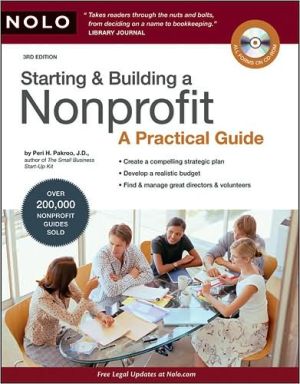Starting and Building a Nonprofit: A Practical Guide
If you're ready to save the world, here's the book you need.\ \ Rescue a school library. Preserve an endangered species. Support the arts. Whatever it is you want to do to give back to your community, Starting & Building a Nonprofit provides the kick start you need.\ \ Filled with user-friendly information, practical advice and step-by-step instructions, this book is your guide through the process of getting your nonprofit up and running. It explains how to:\ \ pick the perfect name for...
Search in google:
If you're ready to save the world, here's the book you need. Rescue a school library. Preserve an endangered species. Support the arts. Whatever it is you want to do to give back to your community, Starting & Building a Nonprofitprovides the kick start you need. Filled with user-friendly information, practical advice and step-by-step instructions, this book is your guide through the process of getting your nonprofit up and running. Accounting Today Offers tons of practical advice and step-by-step instructions...
Introduction\ Changing the world is not a one-person job. Of course, one person can make a difference: Committed, motivated individuals are often the seeds of major social movements or the subjects of inspiring stories about how ordinary people, through passion and tireless dedication, can move mountains for a worthy cause. But there is strength in numbers, and those who want to bring about change are most likely to succeed when they come together with like-minded comrades to work towards a common goal. Nonprofit organizations exist to bring together the people and resources necessary to mount these noble efforts. If you're considering trying to bring about change in your corner of the world by starting a nonprofit, this book will help you make your venture a success.\ \ Many people believe -- mistakenly -- that all nonprofits are underfunded labors of love, kept afloat by the scrappy and tireless efforts of self-sacrificing, long-haired activists. While this description probably fits more than a few nonprofits, there are also plenty of nonprofits that bring in millions of dollars each year, pay hefty salaries to their workers, have swanky corporate offices, and even impose a dress code. In between these extremes, there are scores of nonprofits with varying assets, diverse office cultures, and a wide array of political leanings.\ While the volunteer-driven model of nonprofits is alive and well, more and more nonprofits are adopting the entrepreneurial strategies and business models developed in the for-profit world. Many nonprofit managers and staff members have discovered that working for a nonprofit is a satisfying way to meet important community and societal needsand make a living at the same time, which can be more difficult in the for-profit arena. Whether you're driven purely by a passion for your mission or you want to combine your activist aspirations with a solid career, starting and running a nonprofit can be a great way to achieve your goals.\ This book explains all of the practical steps necessary to start and run a nonprofit, from deciding whether to form a nonprofit in the first place, to engaging in strategic planning, managing your finances and taxes, developing a website, and much more. The first chapter explains some of the choices you'll have to face at the outset, such as what to call your nonprofit, whether to incorporate, and whether to apply for a tax exemption. Each subsequent chapter focuses on an issue you will face when launching your nonprofit, such as choosing a board of directors, fundraising, and marketing. Armed with the information in this book, you'll be ready for the challenges -- and rewards -- that await you in the nonprofit sector.\ Who Should Read This Book\ This book is intended for anyone who is considering starting a nonprofit or reorganizing an existing group. You may be working with a group in its embryonic stages and coming to realize that you need to organize more formally. (Often, a group's lack of structure makes it ineligible for grants, unprepared to hire paid employees, or simply ineffective in its day-to-day operations.) Or, you may just have a goal or passion in mind and want to learn how to create an organization devoted to achieving that goal. You may be a budding founder of a new group, or a staff member or volunteer at an existing group that needs an overhaul. No matter what position you hold or how far along you are in the process of bringing a group together, this book will give you all of the information on nonprofit organization, planning, structures, management, and marketing you need.\ \ \ For the most part, this book assumes that the reader is a founder or board member of an existing or future nonprofit group. However, you may be an executive director, manager, staff member, or volunteer who is researching nonprofit management in order to create or improve your group. Where the information in this book is directed not at the board or founder but at the executive director or other manager, it is noted explicitly.\ \ \ Icons Used in This Book\ Throughout this book you will notice symbols, or icons, that are designed to alert you to certain types of information, as described below.\ This icon highlights a practical tip or good idea.\ This icon alerts you to potential problems.\ This icon indicates that you should consult with an attorney or other expert.\ This icon lets you know that you can skip information that may not be relevant to your situation.\ This icon refers you to related information somewhere else in this book.\ This icon refers you to other helpful books or resources on a topic.\ This icon indicates that something is included on the accompanying CD-ROM.\ Nonprofit Basics\ The term "nonprofit" is often used loosely to describe all kinds of groups that are bound together by a desire to achieve a mission, rather than to make a profit. By itself, the term "nonprofit" does not indicate any specific type of legal structure. If a nonprofit group incorporates, it is a nonprofit corporation; if not, it is an unincorporated nonprofit association. For example, a group of people interested in keeping a local park litter-free would likely be called a nonprofit, as would a group of soccer dads who sell candy bars to fund their children's trips to soccer tournaments around the state. Both groups could be called "nonprofits" because both are mission-driven, not profit-driven -- but they could have different legal structures. If the park group never did anything to create a formal structure, it would technically be considered an unincorporated nonprofit association. If the soccer dads filed inco-rporation papers with the state, the group would be a nonprofit corporation.\ \ \ 1. Nonprofit Corporations\ A nonprofit corporation is an organization that has a mission to serve the public interest and has filed incorporation papers with the state. Because the corporation works for the public good, it receives exemptions from state and federal taxes it would otherwise have to pay -- which means that these groups are, to a certain extent, publicly subsidized.\ The mission-driven nature of nonprofits sets them apart from traditional private businesses, but they're not part of the government, either. (In fact, they are sometimes called nongovernmental organizations or NGOs.) Nonprofits occupy a unique position between the public and private worlds and share some characteristics of each. In exchange for being exempt from many of the taxes that normally apply to private businesses, nonprofits must dedicate themselves to the public interest and govern them-selves according to certain rules designed to ensure accountability.\ To ensure that nonprofit corporations are, in fact, working for the public good -- and earning their tax breaks -- state laws require them to establish certain organizational structures. A nonprofit corporation must have a board of directors (sometimes called a board of trustees), which is responsible for keeping the organization on track, working toward its stated nonprofit mission. Other state rules impose legal duties on the board -- for example, the duty to act with care and the duty to be loyal to the organization -- and ensure that the board does not stand to gain personally from the nonprofit's activities. (These duties are discussed in more detail in Chapter 4.)\ a. Corporations in General\ To create any type of corporation, nonprofit or for-profit, you must file paperwork with the state government -- usually the secretary of state's office. The document you must file with the state to create a corporation is typically called "articles of incorporation." Once you file this document, you have "incorporated" and created a separate legal entity: your corporation. \ \ In the simplest terms, a corporation -- -whether nonprofit or for-profit -- is a type of business structure. Other types of business structures include sole proprietorships, partnerships, and limited liability companies (LLCs). Some states also recognize associations: groups of individuals who work together for some common goal but haven't taken steps to create a specific legal entity. (Chapter 1 explains the pros and cons of structuring your nonprofit as an unincorporated association.)\ The main differences between the various business structures lie in how they handle two important issues: personal liability and taxation.\ \ Personal liability. Some business structures (such as corporations) protect their owners from personal liability, while others (such as sole proprietorships) do not. If the business structure limits its owners' personal liability, the owners' personal assets will be protected if the business is sued or otherwise finds itself in debt. If the business structure does not limit its owners' liability, the owners' personal assets -- such as houses, cars, bank accounts, and so on -- can be taken to satisfy business debts or a lawsuit judgment. Many nonprofits choose to incorporate primarily to receive this liability protection.\ Taxation. In some business structures (such as partnerships), business profits are taxed as if they are simply the personal income of the business owners. This is known as "pass-through" taxation -- the profits "pass through" the business to the owners, who report the income on their own personal tax returns. Other business entities (such as corporations) pay and report their own taxes, separate from the owners' personal incomes. The business files its own tax return, as if it were a person. (In fact, you may hear people refer to a corporation as a separate "legal person"; legally, the corporation is a distinct entity that exists separately from its owners.) Nonprofit corporations are separate tax entities but have different -- and more favorable -- tax rules than for-profit corporations.\ \ \ \ b. Forming a Nonprofit\ The steps you must take to form a nonprofit corporation are similar to the procedures for starting a regular corporation, but a bit more involved. Starting a nonprofit corporation is something like getting a commercial driver's license: The process for getting a commercial driver's license is very similar to that for getting a regular driver's license, and the same agency grants both licenses, but you must satisfy a few extra rules to gain the additional privileges and responsibilities that accompany the commercial driver's license. Likewise, creating a nonprofit corporation is very similar to creating a for-profit corporation: To do either, you must apply to the same agency and follow a similar process -- but to create a nonprofit corporation, you must satisfy a few extra rules. \ \ \ \ Corporation Rules Vary by State\ All corporations -- nonprofit and for-profit alike -- are creatures of state law. Although state laws that govern corporations are, for the most part, similar throughout the nation, there are important differences. For example, states vary on the minimum number of directors required for nonprofit boards, as well as other eligibility rules for directors. And corporate tax laws can vary significantly from state to state.\ In addition, corporations created in one state are not automatically qualified to do business in others. If you create your nonprofit corporation in Wisconsin, for example, it is technically a "Wisconsin corporation." Other states will view it as a "foreign corporation" and will generally require you to file paperwork and pay a fee before allowing you to do business within their borders.\ If you do not plan to engage in nonprofit activities in other states, then incorporating in your home state alone is probably sufficient, at least in your early days. If, on the other hand, you expect the scope of your activities or services to extend into other states, you should investigate the requirements for operating as a nonprofit corporation in those other states.
I. Doing Good and Doing it WellWho Should Read This BookNonprofit BasicsRunning a Nonprofit1. Naming and Structuring Your NonprofitChoose a Name for Your NonprofitShould You Incorporate?Do You Want Tax-Exempt Status?Should You Have Voting Members?2. Developing Your Strategic PlanStrategic Plan BasicsDevelop Your Mission StatementOutline Specific Goals, Objectives, and ActivitiesAssess Your ResourcesIdentify StrategiesEdit and Finalize Your Plan3. Developing Your Initial BudgetSet Up Your BudgetEstimate IncomeEstimate ExpensesAssemble Your Budget4. Your Board of DirectorsWhat Makes a Good BoardThe Board's Duties and TasksBoard Policies and ProceduresRecruiting Board MembersHolding Effective Board MeetingsThe Role of Committees5. Your Workforce: Staff and VolunteersDeveloping a Management StrategyHiring an Executive DirectorHiring and Managing Staff and VolunteersEmployees and Independent ContractorsRequired Paperwork, Filings, and Taxes6. FundraisingThe Golden Rules of Successful FundraisingYour Fundraising PlanDefine Your Fundraising Targets and BudgetFind Prospective DonorsDefine Your Fundraising CampaignFundraising ToolsFunding From GrantsThe Law of FundraisingWorking With Professional Fundraisers7. Risk Management and InsuranceCommon Legal ProblemsWho Is at Risk?Managing Your Nonprofit's Risks8. Understanding Contracts and AgreementsContract Law BasicsUsing Contracts in the Real WorldTypical Contract Terms9. Marketing YourNonprofitMarketing and Public Relations at WorkFundamental Marketing ToolsCreating a Website10. Publishing Informational MaterialsDecide Whether to PublishCreate a Publishing PlanCopyright Basics for Nonprofit Publishers11. Managing Your FinancesBookkeeping and Accounting OverviewTracking Income and ExpensesCreating Basic Financial ReportsAudits, Reviews, and CompilationsReporting Requirements12. Getting Professional HelpRelationships Are CriticalWorking With LawyersWorking With Accountants and Other ProfessionalsAppendixesA. How to Use the CD-ROMInstalling the Form Files Onto Your ComputerUsing the Word Processing Files to Create DocumentsB. State Secretary of State or Other Corporate Filing OfficesC. state Charitable Solicitation Registration OfficesD. State Tax AgenciesE. State Sales Tax or Seller's Permit AgenciesF. Forms and ChecklistsChecklist: Naming and Structuring Your NonprofitChecklist: Developing Your Strategic PlanChecklist: Developing Your Initial BudgetChecklist: Your Board of DirectorsChecklist: Your Workforce: Staff and VolunteersChecklist: FundraisingChecklist: Risk Management and InsuranceChecklist: Understanding Contracts and AgreementsChecklist: Marketing Your NonprofitChecklist: Publishing Informational MaterialsChecklist: Managing Your FinancesChecklist: Getting Professional HelpContractor Work-for-Hire AgreementVolunteer Assignment AgreementNonprofit's Initial BudgetIndex
\ Randolph BellePlanning and management, not good intentions, are the keys to success -- this book lays out the framework and insight to make that happen.\ \ \ \ \ Accounting TodayOffers tons of practical advice and step-by-step instructions...\ \ \ Chronicle of PhilanthropyDescribes the steps required to start and run a nonprofit organization, including how to decide whether to form a charity, and how to conduct long-term planning, manage finances, and develop a website.\ \ \ \ \ Association of Small FoundationsOffers practical advice to allow nonprofits to set up their operations so that they run smoothly and efficiently...\ — Deborah Brody Hamilton\ \ \ \ \ East Bay Nonprofit CoalitionEverything needed to start and build a nonprofit -- this resource makes it easy to navigate the startup process and make informed decisions.\ — Mona Lisa Wallace\ \ \ \ \ Chronicle of PhilanthropyDescribes the steps required to start and run a nonprofit organization, including how to decide whether to form a charity, and how to conduct long-term planning, manage finances, and develop a website.\ \ \ \ \ Accounting TodayOffers tons of practical advice and step-by-step instructions...\ \ \ \ \ Library JournalAiming to explain all the "practical steps necessary to start and run a nonprofit," media and communications consultant Pakroo (The Small Business Start-Up Kit) takes readers through the nuts and bolts, from deciding on a name to bookkeeping. This guide offers advice on organizing the company, signing contracts, marketing, budgeting, and handling taxes and insurance. Pakroo notes special issues for nonprofits, such as their tax-exempt status and an organizational structure requiring "a board of directors which is responsible for keeping the Organization on track, working toward its stated nonprofit mission." In addition to the how-to chapters, there are helpful appendixes, including a directory of web sites (where incorporation information and forms may be requested), state charitable solicitation registration offices, and state tax agencies. She also appends a checklist of steps to take (e.g., developing your initial budget) and sample forms, including budget worksheets. The accompanying CD-ROM contains digital copies of the forms included in one appendix. In explaining the special issues involved in establishing and running a nonprofit, this book does fill a need. Recommended primarily for public libraries, although nonprofit agencies should also keep it on their shelves.-Lucy Heckman, St. John's Univ., Jamaica, NY Copyright 2005 Reed Business Information.\ \








